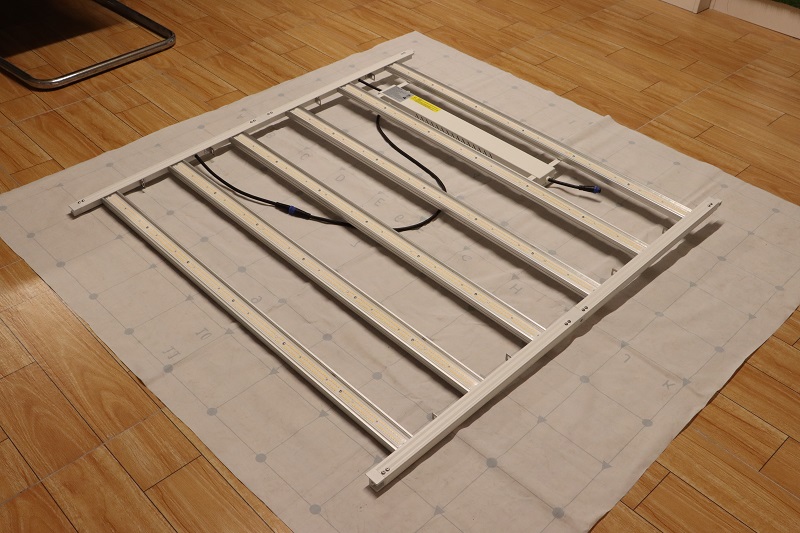Light is the energy source for photosynthesis in plants and is the primary factor that determines growth rate and yield.
Intensity (PPFD): The intensity of light must be sufficient. Too weak, the plant will grow slowly and thin; too strong, it may burn the leaves. Light intensity is usually measured by PPFD (photosynthetic photon flux density).
Spectrum: Plants need different colors of light at different growth stages.
Seedling/vegetative growth stage: prefer blue light to promote the healthy growth of stems and leaves.
Flowering/fruiting stage: prefer red light to promote flower bud differentiation and fruit enlargement.
Full Spectrum: The ideal growth lamp can simulate sunlight and provide a full spectrum of light from blue to red and in between.
Duration (Photoperiod): The length of light and dark time each day. This is crucial to control the transition of plants from the vegetative growth stage to the flowering stage. For example, many plants need 12 hours of complete darkness per day before they start to bloom.

Refers to the air environment around the plant, mainly including temperature, humidity and air exchange.
Temperature: Most plants prefer daytime temperatures between 22-28°C. Nighttime temperatures should be slightly lower to simulate the natural environment, which helps plants "rest" and store energy. Too high or too low temperatures will stagnate plant growth.
Relative Humidity (RH): The moisture content in the air.
Seedling stage: Higher humidity (60-70%) is required because the root system is not fully developed.
Vegetative growth period: Humidity can be appropriately reduced (50-60%).
Flowering stage: Lower humidity (40-50%) is required to prevent the flowers from getting moldy.
Air Exchange & Circulation:
Fresh Air Supply: Constantly provide plants with fresh air rich in **carbon dioxide (CO₂) **, which is a key raw material for photosynthesis.
Internal Air Circulation: Using a small fan to create a breeze around the plant canopy can strengthen the stems, prevent heat and moisture from accumulating around the leaves, and effectively prevent mold and pests.
The medium is the home of the plant's roots, providing support, water and nutrients for the plant.
Types: Including soil (Soil), Coco Coir (Coco Coir), Hydroponics (Hydroponics), etc. Each medium has different water retention, air permeability and nutrient supply methods.
Permeability: Roots need to breathe too! The medium must have good drainage and air permeability to prevent roots from rotting due to lack of oxygen.
pH: The acidity (pH) of the medium directly affects the plant's ability to absorb nutrients. Most plants prefer a pH range between 5.8 and 6.5. If the pH is not within this range, even if there is sufficient nutrients in the medium, the plant cannot absorb them.
Nutrients are the "building materials" that make up the plant itself.
Macronutrients: The three elements with the highest demand, usually indicated by N-P-K on fertilizer packaging.
Nitrogen (N): Promotes leaf and stem growth.
Phosphorus (P): Essential for root development, flowering and energy conversion.
Potassium (K): Regulates water, enhances stress resistance and supports overall function.
Trace elements: Such as calcium, magnesium, sulfur, iron, manganese, etc., although the demand is small, they are indispensable.
Feed on demand: Plants have different nutrient requirements at different growth stages. High nitrogen is needed during the vegetative growth period, and high phosphorus and potassium are needed during the flowering period.
Water is the source of life and participates in almost all physiological processes in plants.
When and how much to water: The key principle is "water when dry". That is, wait until the surface of the medium is dry for a few centimeters before watering, and water thoroughly at one time until the excess water flows out from the bottom of the pot. Overwatering can cause roots to rot due to lack of oxygen, which is one of the most common mistakes made by beginners.
Water Quality (Quality):
pH: The pH of water also affects nutrient absorption and needs to be adjusted before use.
EC/PPM: The electrical conductivity (EC) or parts per million (PPM) of water is a measure of the total dissolved solids (including nutrients) concentration in water. Monitoring this value can avoid excessive or insufficient nutrients.
In summary, the key to creating an ideal environment is "balance" and "synergy". These five factors are interdependent, and you need to make them play in harmony like a conductor to cultivate the healthiest and most productive plants.
Luxgrow is developed by photology engineers and more than 13 years R & D engineers team in led lights
As a professional and rich experience grow light designer and manufacturer for indoor greenhouse farms ; Luxgrow really knows offer the exclusive customized layout service is very necessary and cost-efficient.
We offer free exclusive customized layout service for customers , not only in the lighting configuration help,but also help you know the budget
 Whatsapp
Whatsapp